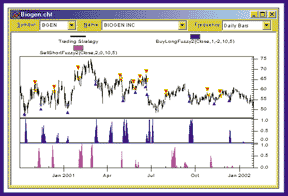Gaining An Edge To Chart Pattern Recognition
Trading Fuzzy Patterns
by Marge Sherald
Here's how you can apply fuzzy logic and increase your profits.
Ask around and you'll discover that every trader has a chart pattern he or she swears by, one that will indicate what the next big move in the market will be. But ask those traders to precisely define their patterns, and you'll find that although each pattern looks similar, they do not exactly match any set definition. This makes pattern recognition an ambiguous or "fuzzy" task, which may be why fuzzy logic is beginning to be used by traders to recognize chart patterns.
Fuzzy logic is not some new, theoretical idea that has yet to catch on. It's been around for a while; in fact, by 1990 the Japanese had more than 100 real fuzzy control applications and products in use. The Japanese city of Sendai has controlled its subway with fuzzy logic since 1988. General Motors' highly successful automobile model, the Saturn, applies fuzzy logic for automatic transmission shift control, as does Volkswagen's new Beetle. Duke University engineers have shown that intentionally imprecise rules of thinking can help hotel computers sell the right room to the right customer at the right time, thus boosting income. There is even talk of using fuzzy logic on income taxes.
Bart Kosko has been a proponent of fuzzy logic in the academic world since 1984. According to Kosko: "Most math guesses are contrived and brittle, and change in big ways if you change only a small value in them. Man has walked Earth for at least a million years and has just started to think in math, and is not good at it. Fuzzy systems let us model systems in words."
The ways that fuzzy words can be translated into numbers and control systems is described in the sidebar, "How does fuzzy logic work?"

Figure 1: Fuzzy pattern indicators. In Biogen (BGEN), separate fuzzy pattern indicators generate buy long and sell short signals.
Excerpted from an article originally published in the September 2002 issue of Technical Analysis of STOCKS & COMMODITIES magazine. All rights reserved. © Copyright 2002, Technical Analysis, Inc.